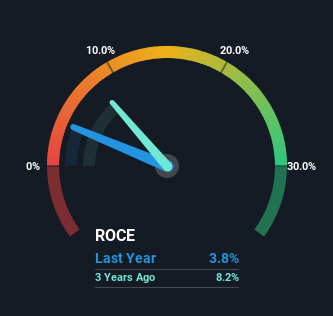If you're looking for a multi-bagger, there's a few things to keep an eye out for. Ideally, a business will show two trends; firstly a growing return on capital employed (ROCE) and secondly, an increasing amount of capital employed. Ultimately, this demonstrates that it's a business that is reinvesting profits at increasing rates of return. However, after briefly looking over the numbers, we don't think Tomoe (TSE:1921) has the makings of a multi-bagger going forward, but let's have a look at why that may be.
Understanding Return On Capital Employed (ROCE)
For those that aren't sure what ROCE is, it measures the amount of pre-tax profits a company can generate from the capital employed in its business. To calculate this metric for Tomoe, this is the formula:
Return on Capital Employed = Earnings Before Interest and Tax (EBIT) ÷ (Total Assets - Current Liabilities)
0.038 = JP¥3.7b ÷ (JP¥113b - JP¥16b) (Based on the trailing twelve months to September 2024).
Therefore, Tomoe has an ROCE of 3.8%. Ultimately, that's a low return and it under-performs the Construction industry average of 9.1%.
Check out our latest analysis for Tomoe

Historical performance is a great place to start when researching a stock so above you can see the gauge for Tomoe's ROCE against it's prior returns. If you're interested in investigating Tomoe's past further, check out this free graph covering Tomoe's past earnings, revenue and cash flow.
What Can We Tell From Tomoe's ROCE Trend?
In terms of Tomoe's historical ROCE movements, the trend isn't fantastic. Around five years ago the returns on capital were 8.1%, but since then they've fallen to 3.8%. And considering revenue has dropped while employing more capital, we'd be cautious. This could mean that the business is losing its competitive advantage or market share, because while more money is being put into ventures, it's actually producing a lower return - "less bang for their buck" per se.
On a related note, Tomoe has decreased its current liabilities to 14% of total assets. So we could link some of this to the decrease in ROCE. What's more, this can reduce some aspects of risk to the business because now the company's suppliers or short-term creditors are funding less of its operations. Some would claim this reduces the business' efficiency at generating ROCE since it is now funding more of the operations with its own money.
The Key Takeaway
In summary, we're somewhat concerned by Tomoe's diminishing returns on increasing amounts of capital. Since the stock has skyrocketed 183% over the last five years, it looks like investors have high expectations of the stock. Regardless, we don't feel too comfortable with the fundamentals so we'd be steering clear of this stock for now.
Tomoe does have some risks though, and we've spotted 2 warning signs for Tomoe that you might be interested in.
While Tomoe may not currently earn the highest returns, we've compiled a list of companies that currently earn more than 25% return on equity. Check out this free list here.
Valuation is complex, but we're here to simplify it.
Discover if Tomoe might be undervalued or overvalued with our detailed analysis, featuring fair value estimates, potential risks, dividends, insider trades, and its financial condition.
Access Free AnalysisHave feedback on this article? Concerned about the content? Get in touch with us directly. Alternatively, email editorial-team (at) simplywallst.com.
This article by Simply Wall St is general in nature. We provide commentary based on historical data and analyst forecasts only using an unbiased methodology and our articles are not intended to be financial advice. It does not constitute a recommendation to buy or sell any stock, and does not take account of your objectives, or your financial situation. We aim to bring you long-term focused analysis driven by fundamental data. Note that our analysis may not factor in the latest price-sensitive company announcements or qualitative material. Simply Wall St has no position in any stocks mentioned.
About TSE:1921
Tomoe
Operates in the general construction, steel structures construction, and real estate businesses in Japan.
Solid track record with adequate balance sheet.
Market Insights
Community Narratives




